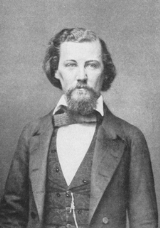
Clement Comer Clay
Encyclopedia
Clement Comer Clay was the eighth Governor of the U.S. state
of Alabama
from 1835 to 1837.
Clay was born in Halifax County, Virginia. His father, William Clay, was an officer in the American Revolutionary War
, who moved to Grainger County, Tennessee, after the war. Clay attended public schools and graduated from East Tennessee College in 1807. He was admitted to the bar
in 1809 and moved to Huntsville, Alabama
, where he began a law practice in 1811. Clay served in the Alabama Territorial Legislature 1817-1818. He was a state court judge and served in the Alabama House of Representatives
.
Prior to being governor of Alabama he had served in the U.S. House of Representatives from March 4, 1829 until March 3, 1835. Clay's term as governor ended early when he was appointed to the United States Senate
, where he served from June 19, 1837 until his resignation on November 15, 1841.
In 1836, Governor Clay signed a legislative act which chartered the third oldest Jesuit college in the United States, Spring Hill College
in Mobile, Alabama
, and gave it "full power to grant or confer such degree or degrees in the arts and sciences, or in any art or science as are usually granted or conferred by other seminaries of learning in the United States."
Clay married Susannah Claiborne Withers on 4 April 1815. They had three sons - Clement Claiborne Clay
, John Withers Clay and Hugh Lawson Clay. Clement died of natural causes in September 1866, aged 76. Susanna had died earlier the same year.
U.S. state
A U.S. state is any one of the 50 federated states of the United States of America that share sovereignty with the federal government. Because of this shared sovereignty, an American is a citizen both of the federal entity and of his or her state of domicile. Four states use the official title of...
of Alabama
Alabama
Alabama is a state located in the southeastern region of the United States. It is bordered by Tennessee to the north, Georgia to the east, Florida and the Gulf of Mexico to the south, and Mississippi to the west. Alabama ranks 30th in total land area and ranks second in the size of its inland...
from 1835 to 1837.
Clay was born in Halifax County, Virginia. His father, William Clay, was an officer in the American Revolutionary War
American Revolutionary War
The American Revolutionary War , the American War of Independence, or simply the Revolutionary War, began as a war between the Kingdom of Great Britain and thirteen British colonies in North America, and ended in a global war between several European great powers.The war was the result of the...
, who moved to Grainger County, Tennessee, after the war. Clay attended public schools and graduated from East Tennessee College in 1807. He was admitted to the bar
Bar (law)
Bar in a legal context has three possible meanings: the division of a courtroom between its working and public areas; the process of qualifying to practice law; and the legal profession.-Courtroom division:...
in 1809 and moved to Huntsville, Alabama
Huntsville, Alabama
Huntsville is a city located primarily in Madison County in the central part of the far northern region of the U.S. state of Alabama. Huntsville is the county seat of Madison County. The city extends west into neighboring Limestone County. Huntsville's population was 180,105 as of the 2010 Census....
, where he began a law practice in 1811. Clay served in the Alabama Territorial Legislature 1817-1818. He was a state court judge and served in the Alabama House of Representatives
Alabama House of Representatives
The Alabama House of Representatives is the lower house of the Alabama Legislature, the state legislature of the U.S. state of Alabama. The House is composed of 105 members representing an equal amount of districts, with each constituency containing at least 42,380 citizens. There are no term...
.
Prior to being governor of Alabama he had served in the U.S. House of Representatives from March 4, 1829 until March 3, 1835. Clay's term as governor ended early when he was appointed to the United States Senate
United States Senate
The United States Senate is the upper house of the bicameral legislature of the United States, and together with the United States House of Representatives comprises the United States Congress. The composition and powers of the Senate are established in Article One of the U.S. Constitution. Each...
, where he served from June 19, 1837 until his resignation on November 15, 1841.
In 1836, Governor Clay signed a legislative act which chartered the third oldest Jesuit college in the United States, Spring Hill College
Spring Hill College
Spring Hill College is a private, Roman Catholic Jesuit liberal arts college in the United States. It was founded in 1830 on the Gulf Coast in Mobile, Alabama, by Most Rev. Michael Portier, Bishop of Mobile, Alabama...
in Mobile, Alabama
Mobile, Alabama
Mobile is the third most populous city in the Southern US state of Alabama and is the county seat of Mobile County. It is located on the Mobile River and the central Gulf Coast of the United States. The population within the city limits was 195,111 during the 2010 census. It is the largest...
, and gave it "full power to grant or confer such degree or degrees in the arts and sciences, or in any art or science as are usually granted or conferred by other seminaries of learning in the United States."
Clay married Susannah Claiborne Withers on 4 April 1815. They had three sons - Clement Claiborne Clay
Clement Claiborne Clay
Clement Claiborne Clay was a U.S. senator from the state of Alabama from 1853 to 1861, and a C.S.A. senator from the Alabama from 1861 to 1863...
, John Withers Clay and Hugh Lawson Clay. Clement died of natural causes in September 1866, aged 76. Susanna had died earlier the same year.

